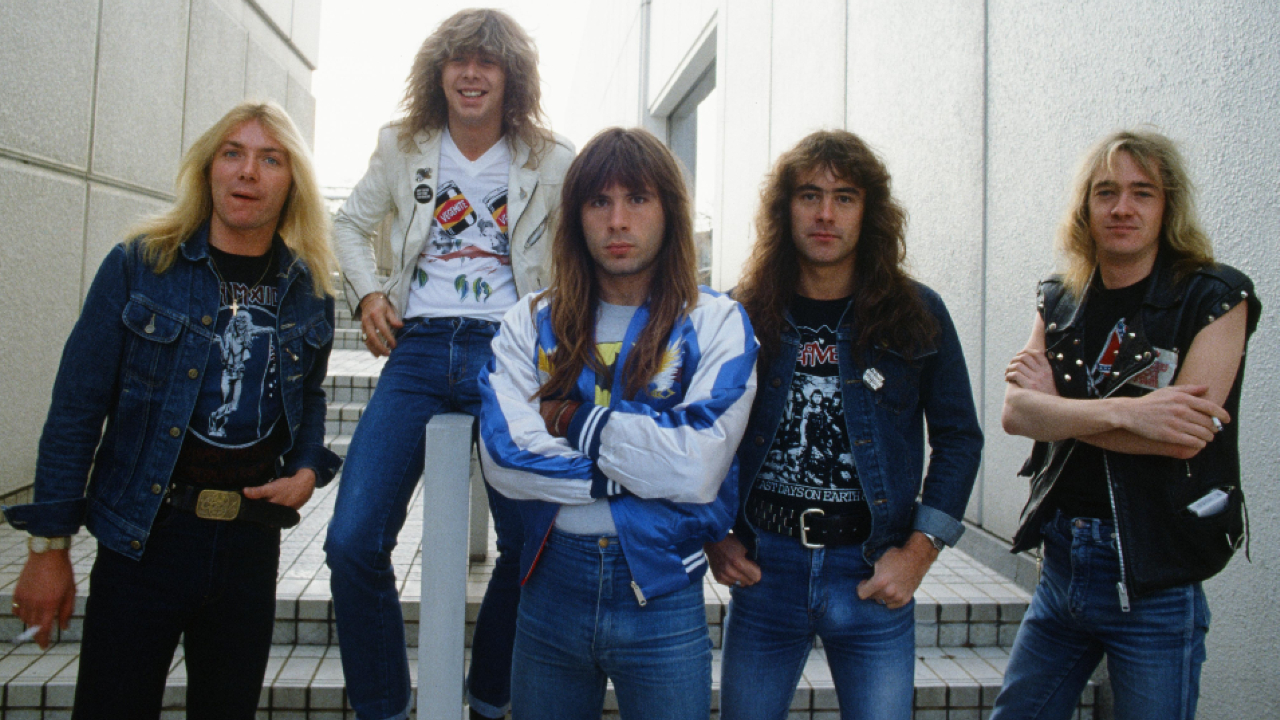“The kids who wanted to buy our records were like, ‘Cool! The religious right’s burning them!’” The track-by-track guide to Iron Maiden’s The Number Of The Beast
From Invaders to Hallowed Be Thy Name, here’s everything you need to know about each song on Iron Maiden’s 1982 breakthrough

No matter how you look at it, The Number Of The Beast is the moment Iron Maiden were catapulted into the mainstream. Run To The Hills cracked the top 10 of the singles charts in the band’s native UK, before the album itself landed at the wildly enviable number one position. The US, meanwhile, was getting worked up by all the satanic imagery, staging mass protests that – unbeknownst to them – only made Maiden seem even cooler to metalheads.
Of course, none of that success would have been possible if Number… were shit. It took eight top-shelf songs to build this career-defining masterpiece (or nine if you own the CD), and below you’ll find the story of every single one. From Invaders to Hallowed Be Thy Name, here’s your track-by-track guide to Maiden’s magnum opus:

Invaders
A bold and upfront thrasher, Invaders opens Number… with attention-demanding immediacy. There’s no build-up, just brash metal chords and Clive Burr’s forceful drumming separated by Steve Harris’ characteristically loud bass. Despite it starting their biggest album, though, the band have since stated they’re not big fans of the song.
“[Invaders] could have been replaced with something a bit better, only we didn’t have anything else to replace it with at the time,” Steve said in Maiden biography Run To The Hills. “We had just enough time to do what we did, and that was it.”
To this day, Maiden have never played this song live.
Children Of The Damned
After the no-wasted-space onslaught of Invaders, Children Of The Damned is a more dynamic meander. The song routinely escalates from acoustic verses to cacophonous electric guitar chords, and the shifts in tone offered the first true glimpse of then-new singer Bruce Dickinson’s range.
Freshly removed from ex-band Samson, Bruce wasn’t allowed writing credits on Number…, but made a “moral contribution” to several tracks, including this one. The frontman’s said Children… was inspired by Black Sabbath’s 1980 anthem Children Of The Sea, as well as the ’60s science-fiction horror films Children Of The Damned and Village Of The Damned.
Sign up below to get the latest from Metal Hammer, plus exclusive special offers, direct to your inbox!
The Prisoner
Famously, The Prisoner was inspired by (and samples its opening dialogue from) the 1960s TV series of the same name. Guitarist Adrian Smith, who’d only joined Maiden in 1981, came up with the track, marking his first songwriting contribution to the band.
“I was pretty shy about showing the band my songs,” Adrian told Classic Rock. “[…] But I thought that if I wanted to stay in the band I’d get pretty frustrated if I didn’t contribute ideas.”
The Prisoner creator Patrick McGoohan was reportedly supportive of the song sampling the show, telling manager Rod Smallwood: “What did you say the name was? Iron Maiden? Do it!”
22 Acacia Avenue
Adrian Smith and Steve Harris co-composed this song as a sequel to Charlotte The Harlot: a track on Maiden’s self-titled debut, written by guitarist Dave Murray about a fictional sex worker. “It’s an extension of Charlotte The Harlot,” Steve said in a 1983 interview. “[22 Acacia Avenue] is where she’s living in London’s East End.”
Although Maiden would later revisit Charlotte twice more (1990’s Hooks In You and 1992’s From Here To Eternity), none of the songs about her have persisted in the setlist. 22…, despite being a fixture during the ’82 Beast On The Road tour, hasn’t been played since 2003.
The Number Of The Beast
Inspired by a nightmare Steve Harris had after watching Damien: The Omen II, Number… became one of Maiden’s signature songs by drawing the ire of religious fundamentalists in the US. “It gave us loads of publicity,” Bruce Dickinson said in 2005. “The kids who did wanna buy our records were like, ‘Oh cool! The religious right are burning their records! I better buy half a dozen!’”
The title track was also an arse-ache to record. Producer Martin Birch had Bruce repeat that agonised wail after the third verse over and over again, to the point the vocalist began throwing furniture around out of frustration.
Run To The Hills
Steve Harris drew from his love of Western stories to write Iron Maiden’s most popular song. Run To The Hills narrates the struggles of the Native American Cree tribe as they’re hunted by colonial forces. Musically, it marked the epitome of Steve’s “galloping” style of bass playing, and its energy and infectious chorus pushed it to number seven in the UK singles chart.
According to Bruce, it was Martin Birch that suggested Run… should be released as Number…’s single. “So, thanks to Martin’s prize-winning ears,” he’s said, “that’s what we did, and it turned out to be exactly the right choice.”
Gangland
Iron Maiden fucking loathe Gangland. In the mad-dash lead-up to Run To The Hills’ single release, the band had to pick a b-side for the song. They chose Total Eclipse, effectively disqualifying it from the album, and replaced it on Number… with this concise hard rocker. For 40 years now, the band’s members have been publicly lamenting that decision.
“The one mistake we made was putting Gangland on the album instead of Total Eclipse,” Bruce Dickinson told Classic Rock. “We picked Gangland because it was the first thing we ever recorded together properly.”
Like Invaders, Gangland has never been played live.
Total Eclipse
Maiden have done everything they can to address Total Eclipse’s omission from Number… since 1982. For starters, the band made the song a mainstay of the setlist during their Beast On The Road run, then they added it to the album’s track listing for both a 1998 CD release and 2022 vinyl reissue. It even replaced Gangland on the latter occasion.
In fairness, few would argue Gangland’s a better song than Total…. The gloriously overblown stomper demonstrates Bruce Dickinson at his most wicked-sounding (especially as he cries, “Mother nature’s black revenge!”), and would have segued seamlessly into the even more dramatic Hallowed Be Thy Name.
Hallowed Be Thy Name
Iron Maiden have made many, many long-running songs, but Hallowed Be Thy Name remains the measuring stick. This ever-expanding triumph conveys the thoughts of a prisoner being taken to the gallows, increasing in bombast and intensity as his death draws nearer.
Hallowed… remains a fan favourite four decades on, and Maiden themselves seem just as enamoured: the band have played this finale at almost every show since 1982. Bruce Dickinson’s likened singing the song onstage to “narrating a movie to the audience”. Metal Hammer’s readers once even voted Hallowed… as the greatest Maiden song, proving both its staying power and you lot’s impeccable taste.

Louder’s resident Gojira obsessive was still at uni when he joined the team in 2017. Since then, Matt’s become a regular in Metal Hammer and Prog, at his happiest when interviewing the most forward-thinking artists heavy music can muster. He’s got bylines in The Guardian, The Telegraph, The Independent, NME and many others, too. When he’s not writing, you’ll probably find him skydiving, scuba diving or coasteering.
